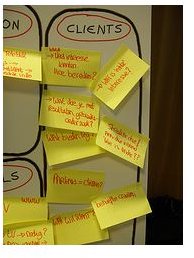Scrum Methodology: What Is the Client's Role?
The Client’s Role
To involve your client when using Scrum, you’ll need to make sure they are monitoring the product backlog. This is a key element in the Scrum methodology process and the client is responsible for making entries or adjustments to the project throughout the project process. While the client is responsible for the upkeep of the product backlog, your team is responsible for developing the client’s requests.
When it’s time for the Scrum sprint meeting which are usually held at landmark points of the project, if the client hasn’t reviewed or provided the team information on what needs to be done, chances are, you team isn’t doing anything or doing it wrong.
As a project manager or Scrum master, you need to carefully orchestrate everyone’s involvement as defined by their roles in Scrum methodology. Because the client is the product owner, they are responsible for the cost of production of the product or the business value of the outcome of your project. You client gives the “what” of the project with clear descriptions, key points and suggestions on how it will work. Ignoring the client or not involving the client will create a gap and you’ll lose effectiveness.
For tips on how to use the Scrum methodology for your project, including client roles, use the Scrum Cheat Sheet found in our Project Management Media Gallery.
Involving the Client
Scrum methodology is a lot like many project management processes. As project manager, you need to ensure the project’s success by involving everyone, including the client. What do you do if you have a client who loves the Scrum idea, but doesn’t want to participate? Here are great tips on keeping the client involved:
- Absence - At your initial project meeting, find out if the client intends to be directly involved and in charge of the product backlog on their own or if they have assigned another person or entity.
- Determination - Explain to clients that to effectively use the Scrum methodology, they HAVE to be involved or the “what” that they want may not be what they get.
- Money talks - Because the client is either the major stakeholder or owner of the project’s outcome, talk money to the client. The client is responsible for claiming, overseeing and recording project dollar requests, so let them know upfront what part of the product process they’ll be losing if they don’t stay involved.
- Make the Client ask questions - An effective way to involve an inactive client in your Scrum process is to report to them in a way that will make them ask questions. This forces the client to be involved, review and be responsible for the product backlog.
- Teamwork - Tell the client their input is important to the entire team effort.
- Risk - Remind clients that their involvement in risk management sessions will ensure swift project endings.
- Reward - Reward the client and team on the burn down chart. This chart should be displayed in a way where everyone involved can see it and be aware of how the project is going. If the client has made a landmark decision, note that on the burn down chart.
- Follow through - Project managers using the Scrum methodology must put up the largest effort when it comes to the client. It is your responsibility to follow through with the client and keep them on board and interested at every level of the project.
Involving the client in Scrum methodology can be as simple as using strong communication skills. If using Scrum and not involving the client, then you aren’t using Scrum effectively and everyone loses.
